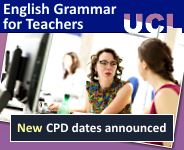Grammar
We define grammar as the study of the structure of words and sentences. As such it is an abstract system, worthy of study in its own right. However, we also see grammar as a system that is used in a range of contexts to unlock meaning. We want to look at grammar not only in written language, but also in spoken English, in a range of multimodal forms, and in all its rich variety.
Welcome back!

Englicious is totally free for everyone to use!
But you will have to log in to see our library of teaching resources.
If you don’t have an account, that’s perfectly OK. You can register (for free).
It only takes a minute or two.
»
- Printer-friendly version
- Log in to view or leave comments

